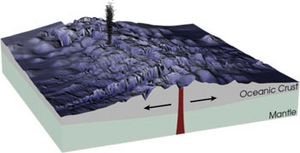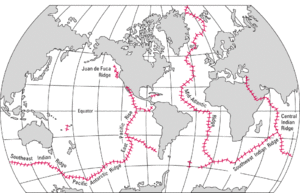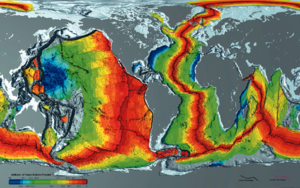Seafloor spreading facts for kids
Seafloor spreading is a process that happens at the bottom of the ocean. It occurs when huge pieces of the Earth's outer layer, called tectonic plates, slowly move away from each other. As these plates pull apart, new ocean floor is created. This new seafloor then moves, carrying the continents along with it.
This process mostly happens at underwater mountain ranges called mid-ocean ridges. Here, hot material from deep inside the Earth, called the mantle, rises up through cracks between the plates. This material cools and hardens, forming new oceanic crust. This new crust then slowly moves away from the ridge. Mid-ocean ridges are places where earthquakes and volcanoes are common.
Seafloor spreading helps us understand continental drift, which is the idea that continents have moved over Earth's history. Older ideas suggested that continents "plowed" through the ocean. But now we know that the ocean floor itself moves and carries the continents as it grows from the mid-ocean ridges. This movement is caused by a slow, churning motion of hot rock deep within the Earth's upper mantle.
The speed at which the seafloor spreads can vary. We classify ridges as fast, intermediate, or slow:
- Fast ridges spread more than 9 centimeters (about 3.5 inches) per year.
- Intermediate ridges spread between 4 and 9 centimeters (about 1.5 to 3.5 inches) per year.
- Slow ridges spread less than 4 centimeters (about 1.5 inches) per year.
Contents
Mid-ocean ridge: Earth's longest mountain range
A mid-ocean ridge is a huge underwater mountain system. It's made up of long chains of mountains with a deep rift valley running down their center. These ridges are formed by plate tectonics where two tectonic plates are pulling apart. This type of boundary is called a divergent boundary.
The mid-ocean ridges around the world are all connected. They form one giant global system that stretches through every ocean. This connected system is the longest mountain range on Earth! It's about 65,000 kilometers (40,000 miles) long, which is many times longer than the Andes, the longest mountain range on land. The total length of the oceanic ridge system is about 80,000 kilometers (50,000 miles).
How new ocean floor is made
Mid-ocean ridges are very active places geologically. New hot, melted rock (called magma) constantly rises up onto the ocean floor and into the Earth's crust. This happens at and near the rifts along the ridge axes. When this magma cools and hardens, it forms new rock, mostly a type called basalt.
The rocks that make up the ocean floor are youngest right at the center of the ridge. As you move further away from the ridge, the rocks get older. This shows that new crust is always being made at the ridge and then moving outwards. The oceanic crust is quite young compared to the Earth itself; it's always less than 200 million years old. It's constantly being "renewed" at these ocean ridges.
As the oceanic crust moves away from the ridge, the ocean depth gets deeper and deeper. The deepest parts of the ocean are found in oceanic trenches, where the old ocean floor eventually sinks back into the Earth. The crust and the solid rock below it form the oceanic lithosphere.
The shape of mid-ocean ridges can differ based on how fast they spread:
- Slow spreading ridges, like the Mid-Atlantic Ridge, have large, wide rift valleys. These valleys can be 10 to 20 kilometers (6 to 12 miles) wide. The terrain at the ridge crest is very rugged and bumpy.
- Fast spreading ridges, like the East Pacific Rise, are much narrower. They have sharp, deep cuts in the seafloor. The land around them is generally flat and slopes gently away from the ridge for hundreds of miles.
Images for kids
See also
 In Spanish: Expansión del fondo oceánico para niños
In Spanish: Expansión del fondo oceánico para niños







